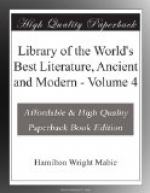The main object of the Bestiaries was not so much to impart scientific knowledge, as by means of symbols and allegories to teach the doctrines and mysteries of the Church: At first this symbolical application was short and concise, but later became more and more expanded, until it often occupied more space than the description of the animal which served as a text.
Some of these animals are entirely fabulous, such as the siren, the phoenix, the unicorn; others are well known, but possess certain fabulous attributes. The descriptions of them are not the result of personal observation, but are derived from stories told by travelers or read in books, or are merely due to the imagination of the author; these stories, passing down from hand to hand, gradually became accepted facts.
These books were enormously popular during the Middle Ages, a fact which is proved by the large number of manuscripts still extant. Their influence on literature was likewise very great. To say nothing of the encyclopaedic works,—such as ‘Li Tresors’ of Brunetto Latini, the ‘Image du Monde,’ the ’Roman de la Rose,’—which contain extracts from the Bestiaries,—there are many references to them in the great writers, even down to the present day. There are certain passages in Dante, Chaucer, and Shakespeare, that would be unintelligible without some knowledge of these mediaeval books of zooelogy.
Hence, besides the interest inherent in these quaint and childish stories, besides their value in revealing the scientific spirit and attainments of the times, some knowledge of the Bestiaries is of undoubted value and interest to the student of literature.
Closely allied to the Bestiaries (and indeed often contained in the same manuscript) are the Lapidaries, in which are discussed the various kinds of precious stones, with their physical characteristics,—shape, size, color, their use in medicine, and their marvelous talismanic properties. In spite of the fact that they contain the most absurd fables and superstitions, they were actually used as text-books in the schools, and published in medical treatises. The most famous of them was written in Latin by Marbode, Bishop of Rennes (died in 1123), and translated many times into Old French and other languages.
The following extracts from the Bestiaries are translated from ’Le Bestiaire’ of Guillaume Le Clerc, composed in the year 1210 (edited by Dr. Robert Reinsch, Leipzig, 1890). While endeavoring to retain somewhat of the quaintness and naivete of the original, I have omitted those repetitions and tautological expressions which are so characteristic of mediaeval literature. The religious application of the various animals is usually very long, and often is the mere repetition of the same idea. The symbolical meaning of the lion here given may be taken as a type of all the rest.
[Illustration: Signature: L. OSCAR KUHNS]




